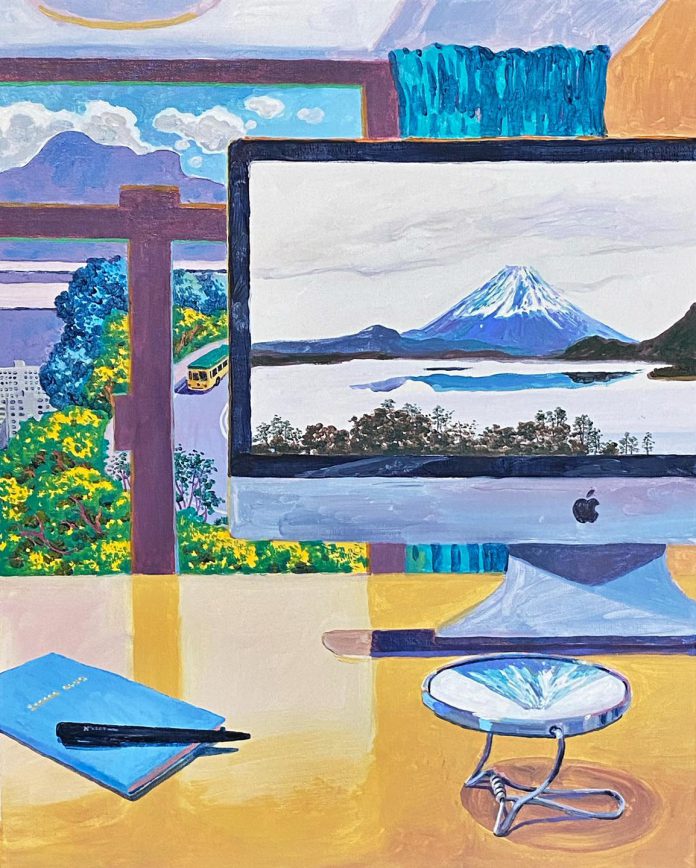Local artists and art organisations are taking creative ways to adapt to the virtual realm under COVID-19 pandemic, but some fear that joys, experiences, and transactions of the art world are hard to replicate on-screen.
By Bonnie Yam
Stephen Wong Chun-hei, who used to do frequent outdoor sketching, can only paint virtual scenery at home now as pandemic wears on.
The 34-year-old landscape artist has started “travelling” and painting with Google Earth since March 2020. He shares his works with his 2,255 followers on Facebook.
Wong has “travelled” to many places, such as Salisbury Cathedral in England, which he visited before, and Merry Cemetery in Romania. Wong also takes virtual tours to some destinations he never thought he could visit in real life, such as unreachable sites around Mount Fuji.

(Photo courtesy of Wong Chun-hei)
Other than painting alone, Wong occasionally invites friends and followers to join his virtual trips by initiating the “Google Earth Sketching Challenge”.
In the challenge, he tags friends under each of his virtual scenery paintings and provides them with a GPS coordinate that refers to a specific place. Individuals taking on the challenge are required to paint the scenery on screen. Participants include Wong’s social media followers, as well as famous local artists Chow Chun-fai and Yeung Hok-tak.

“I am surprised that artists who have not been tagged by me on Facebook still voluntarily join the ‘challenge’,” Wong says. “Although all artists I tagged previously accepted the invitation, there is no large circulation, as it takes time to finish a piece,” Wong adds.
“Though I enjoy sketching with Google Earth, I still prefer doing outdoor sketching. But for the moment, it is the best alternative I have,” he says.
Innovating under the Pandemic
As fears of COVID-19 infection keep buyers away from galleries, exhibitions and networking events, art organisations also innovate by pushing for digital transformation of art sales.
‘Art in the Field’, a local non-profit art organisation, launched a Takeaway Art project in December 2020.
“Shutdown of venues made us rethink the possibility of art under the pandemic,” Roy Wong Chung-him, programme coordinator of Art in the Field, says.

(Photo courtesy of Art in the Field)
Under the project, the team provides administrative service while artists arrange transactions with buyers by themselves.
“We used to work in physical venues that are more controllable and familiar to us,” Wong recalls. “There are many uncertainties with art takeaway, such as the content and venue,” he says.
Although more preparation is needed, he hopes that Takeaway Art can attract artists to employ different art mediums.
Apart from hosting art events online, May Cheung Yuet-ming, chairman of Innovative Arts & Media Association, says many local artists put their works up for sale on online platforms.
Online sales of artworks worldwide accounted for 37 per cent of total sales in the first half of 2020, a huge jump from 10 per cent in 2019, according to a report co-published by UBS and Art Basel.
But Cheung noted that while the online mode boosts flexibility, it is hardly sustainable or scalable.
“As there is no cost for sharing or liking, netizens are more willing to like or share than buying their works,” Cheung says.
“Many netizens bought artworks to support the artists, but not in appreciation of their works. So artists cannot secure continuous income from online platforms,” she explains.
Cheung suggests that artists improve administrative and executive skills, such as writing themselves an attractive bibliography. She points out while most foreign artists have a bibliography, only around 10 per cent of local, non-commercial artists that she knows has one.
“Many netizens bought artworks to support the artists, but not in appreciation of their works. So artists cannot secure continuous income from online platforms.”
A Poor Substitute
While both artists and art organisations actively adapt to the virtual realm, Teresa Kwong Pui-see, Programme Director at Hong Kong Arts Centre, says online mode cannot replace physical events for artistic exchanges.
Kwong was initially surprised by audiences’ active participation during the first online workshop under the Cultural Masseurs Programme in November 2020, as physical ones were cancelled under the pandemic.
The programme was designed to bring art into lives via guided tours, talks, workshops, internship and apprenticeship, as well as the process of art-making.

Source: official website of Cultural Masseurs
“Since audiences now cannot reach out to others physically, they have a strong desire to collaborate, communicate and express themselves,” Kwong says. “So when opportunities for group work come, they are very keen to show great willingness inparticipating,” she adds.
Kwong later finds that online workshops are not an ideal substitute for physical interaction. “We really want to have a chit-chat salon in which guests and artists can mingle. But physical networking events are suspended up until today,” Kwong says.
The Hong Kong government relaxed temporary ban on some businesses on February 18, allowing the re-opening of cinemas, performance venues and museums. But Cultural Masseurs will still hold their workshops online for February and March.
Art lover, Ray Chan Chak, shares Kwong’s view. He finds virtual art experiences unpleasant.
Chan joined the online PolyU Design Degree Show last year, and quit just after 10 minutes of viewing.
“My eyes felt uncomfortable,” Chan recalls. “The sense of reality was absent, so I did not want to continue watching the online exhibition,” he explains.
“I find physical interaction important in artistic activities. As the interaction allows audiences to feel artists’ emotions and thoughts more intimately,” Chan adds.
“The sense of reality was absent, so I did not want to continue watching the online exhibition.”
Editd by Savoki Zhang
Sub-edited by Sarah Ryou







































